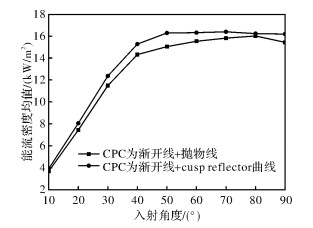


The surface normal in each point is also deter- include relatively simple construction, low wind loads, a mined, and the reflected ray follows the principle that the stationary receiver and high ground usage. of intersection of an incident ray with the reflecting surface are The advantages of linear concentrating Fresnel collectors determined. For reflecting surfaces, the direction and point ing mirrors that concentrate the radiation on a linear receiver. The linear Fresnel collector paths of a large number of rays of incident radiation through- concept uses a number of rows of relatively small one-axis track- out the system. The process consists in following the energy collection on a large scale. A linear Fresnel solar 2 RAY-TRACE SIMULATION collector concentrator may have a lower efficiency than the other concentrating geometries, but the likely reduced cost may well Ray-trace was used for optical efficiency simulations of the compensate that, providing a solution for cost-effective solar concentrating collector. on creating the most efficient system, but more on the develop- ment of a system that has the lowest lifetime cost per unit of elec- tricity converted from solar energy. The solution to this problem does not necessarily lie tors, designed to operate at 2308C.

The maximum temperature achieved in the receiver tubes When looking at reducing CO emissions, the greatest task in was fixed through the operating temperature of an organic creating viable solar energy conversion systems is that of reducing Rankine cycle (power cycle) driven by the linear Fresnel collec- system cost. placed 2.5 m above the mirrors, as shown in Figure 1, inside 1 INTRODUCTION an insulated trapezoidal cavity. Keywords: concentrating solar collector linear Fresnel ray-trace CFD simulation *Corresponding author: Received 19 March 2010 revised 19 March 2010 accepted 21 March 2010. The correlation results are compared with heat transfer coefficients available for linear Fresnel collector prototypes. The simulated global heat transfer coefficient, based on primary mirror area, is correlated with a power-law fit instead of a parabolic fit. The CFD simulation makes possible to optimize cavity depth and rock wool insulation thickness. The number of receiver absorber tubes and the inclination of lateral walls in the cavity are checked with simplified ray-trace simulation. Simulation of a linear Fresnel solar collector concentrator Simulation of a linear Fresnel solar collector concentratorĪ trapezoidal cavity receiver for a linear Fresnel solar collector is analysed and optimized via ray-trace and computational fluid dynamics (CFD) simulations.


 0 kommentar(er)
0 kommentar(er)
